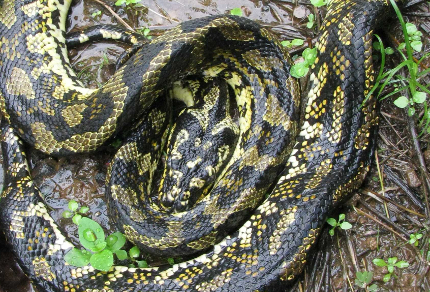I need a python. A big one. And a wild one. I want it to assume residence on my roof and eat every possum within sight or smell so I can sleep. The past few nights in our rental house have been like living under a bowling alley. The thuds of bodies and palm fruits landing on corrugated metal. The scampering of footsteps (a.k.a. ‘possum dancing.’). The occasional wild screech or sliding crash – into something. At bedtime last night, Vilis and I heard a deep, breathy hissing sound emanating from right outside our bathroom. I thought we were in luck. Vilis went out with a flashlight, but the sound vaporized and whatever had produced it remained hidden and silent. I know pythons hiss, but what exactly does a python hiss sound like?
Australia is home to 13 species of pythons, which are tropical, constricting, non-venomous snakes.1 They range in size from the 60-centimetre pygmy python of Western Australia – the world’s smallest python2 – to the scrub or amethystine python, which frequently grows to 5 metres in length and has been reported to reach 8 metres.3 (An 8-metre python on my roof would take care of the possum dancing, all right.) Coastal North Queensland is blessed with an abundance of pythons, namely the spotted python, black-headed python, water python, carpet python, green python, and yes, the big guy, the scrub or amethystine python.4
The Australian pythons exhibit striking colours and patterns of colours, from the eye-popping lime green of the green python inhabiting Cape York rainforests, to the brown, yellow, and black splotches, zigzags, and diamonds of the carpet, spotted, black-headed, and scrub pythons. The water python is in a class by itself, its glossy, dark scales possessing an iridescent sheen that, when caught in the light, transform this snake into a slithering rainbow.5

Jungle Carpet Python on McNamee Creek Trail (© Vilis Nams)
I’ve been looking for pythons. I’ve looked for them in trees and on rock outcrops around Townsville, and in rainforest river gorges, where they supposedly like to sun themselves on exposed rocks. So far, I haven’t found any, with the exception of a dead jungle carpet python that Vilis, Janis and I saw coiled up on the track to McNamee Creek in the Misty Mountains. That python had obviously eaten prior to dying, since its abdomen possessed a noticeable bulge. Interestingly, when I described this snake to Gus McNab, a keen, young herpetologist who worked with Vilis and Janis in Western Australia in May and June, he said that pythons often eat flying foxes, whose wing bones are so sharp they can punture a python’s stomach. Perhaps a swallowed flying fox got its own back with its beautiful killer.
So, yes, I still need a python, or preferably more than one. Alive. One for the possums, and the rest – at a distance – for my camera and me.
Reference:
1. Steve Wilson and Gerry Swan. A Complete Guide to Reptiles of Australia, 2nd edition. 2008. New Holland Publishers (Australia) Pty Ltd, Sydney, p. 392; 2. Ibid, p. 394; 3. Ibid, p. 400; 4. Ibid, pp. 394, 396, 398, 400, 402; Ibid, pp. 395, 397, 399, 401, 403.


